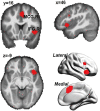Inhibitory Control in Aging: The Compensation-Related Utilization of Neural Circuits Hypothesis
- PMID: 35967887
- PMCID: PMC9371469
- DOI: 10.3389/fnagi.2021.771885
Inhibitory Control in Aging: The Compensation-Related Utilization of Neural Circuits Hypothesis
Abstract
As one of the core executive functions, inhibitory control plays an important role in human life. Inhibitory control refers to the ability to suppress task irrelevant information both internally and externally. Modern cognitive neuroscience has extensively investigated the neural basis of inhibitory control, less is known about the inhibitory control mechanisms in aging. Growing interests in cognitive declines of aging have given raise to the compensation-related utilization of neural circuits hypothesis (CRUNCH). In this review, we survey both behavioral, functional, and structural changes relevant to inhibitory control in aging. In line with CRUNCH, we found that older adults engage additional brain regions than younger adults when performing the same cognitive task, to compensate for declining brain structures and functions. Moreover, we propose CRUNCH could well take functional inhibitory deficits in older adults into account. Finally, we provide three sensible future research directions.
Keywords: CRUNCH; aging; cognitive aging; cognitive decline; compensation-related utilization of neural circuits hypothesis; inhibitory control.
Copyright © 2022 Kang, Wang and Malvaso.
Conflict of interest statement
The authors declare that the research was conducted in the absence of any commercial or financial relationships that could be construed as a potential conflict of interest.
Figures
Similar articles
-
The CRUNCH model does not account for load-dependent changes in visuospatial working memory in older adults.Neuropsychologia. 2020 May;142:107446. doi: 10.1016/j.neuropsychologia.2020.107446. Epub 2020 Mar 29. Neuropsychologia. 2020. PMID: 32234498
-
Multimodal Imaging of Brain Activity to Investigate Walking and Mobility Decline in Older Adults (Mind in Motion Study): Hypothesis, Theory, and Methods.Front Aging Neurosci. 2020 Jan 8;11:358. doi: 10.3389/fnagi.2019.00358. eCollection 2019. Front Aging Neurosci. 2020. PMID: 31969814 Free PMC article.
-
Brain compensation during visuospatial working memory in premanifest Huntington's disease.Neuropsychologia. 2020 Jan;136:107262. doi: 10.1016/j.neuropsychologia.2019.107262. Epub 2019 Nov 14. Neuropsychologia. 2020. PMID: 31734228
-
Combined frontal and parietal P300 amplitudes indicate compensated cognitive processing across the lifespan.Front Aging Neurosci. 2014 Oct 24;6:294. doi: 10.3389/fnagi.2014.00294. eCollection 2014. Front Aging Neurosci. 2014. PMID: 25386141 Free PMC article.
-
Hemispheric organization of the brain and its prevailing impact on the neuropsychology of aging.Handb Clin Neurol. 2025;208:169-180. doi: 10.1016/B978-0-443-15646-5.00004-X. Handb Clin Neurol. 2025. PMID: 40074395 Review.
Cited by
-
Compensatory brain activity pattern is not present in older adults during the n-back task performance-Findings based on EEG frequency analysis.Front Psychol. 2024 Apr 11;15:1371035. doi: 10.3389/fpsyg.2024.1371035. eCollection 2024. Front Psychol. 2024. PMID: 38666231 Free PMC article.
-
Aberrant neuronal hyperactivation causes an age-dependent behavioral decline in Caenorhabditis elegans.Proc Natl Acad Sci U S A. 2025 Jan 7;122(1):e2412391122. doi: 10.1073/pnas.2412391122. Epub 2024 Dec 31. Proc Natl Acad Sci U S A. 2025. PMID: 39739791 Free PMC article.
-
Aging impairs reactive attentional control but not proactive distractor inhibition.J Exp Psychol Gen. 2024 Jul;153(7):1938-1959. doi: 10.1037/xge0001602. Epub 2024 May 23. J Exp Psychol Gen. 2024. PMID: 38780565 Free PMC article.
-
Functional Training and Dual-Task Training Improve the Executive Function of Older Women.Geriatrics (Basel). 2023 Aug 22;8(5):83. doi: 10.3390/geriatrics8050083. Geriatrics (Basel). 2023. PMID: 37736883 Free PMC article.
-
Cerebral hyperactivation across the Alzheimer's disease pathological cascade.Brain Commun. 2024 Oct 25;6(6):fcae376. doi: 10.1093/braincomms/fcae376. eCollection 2024. Brain Commun. 2024. PMID: 39513091 Free PMC article. Review.
References
-
- Aron A. R., Robbins T. W., Poldrack R. A. (2004). Inhibition and the right inferior frontal cortex. Trends Cognit. Sci. 8 170–177. - PubMed
Publication types
LinkOut - more resources
Full Text Sources
Research Materials


